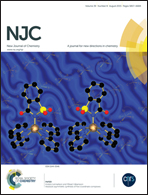Quality by design based development of a selective stability-indicating UPLC method of dolutegravir and characterization of its degradation products by UPLC-QTOF-MS/MS†
Abstract
Dolutegravir (DTG), a selective human immunodeficiency virus (HIV) integrase enzyme inhibitor, was subjected to hydrolytic (acidic, alkaline and neutral), oxidative, photolytic and thermal stress conditions as per the ICH guidelines. The drug degraded under hydrolytic and photolytic stress conditions, while it was stable under oxidative and thermal conditions. A total of 14 hitherto unknown degradation products were formed. The quality by Design (QbD) principle was applied to develop a fast and selective separation of dolutegravir and its degradation products. The developed methodology was based on a design of experiment (DOE) approach to investigate the critical process parameters of chromatographic systems. Effective chromatographic separation was achieved on a Waters Acquity UPLC using a phenyl hexyl (100 × 2.1 mm, 1.7 μm) column with the gradient elution of 10 mM acetate buffer (pH 4.0) and methanol as the mobile phase. The gradient program was set from 15% to 65% of methanol over 5 min (then held for 6 min) at a flow rate of 0.3 mL min−1. The method was extended to UPLC-quadrupole time-of-flight tandem mass spectrometry (QTOF-MS/MS) for the structural characterization of fourteen degradation products, which includes two new diastereomers, H3 (4S, 12aS) and H4 (4R, 12aR), and two carboxylated degradation products (H1 and H2), formed under hydrolytic stress conditions. The drug also degraded to ten different products (P1–P10) under photolytic stress conditions.


 Please wait while we load your content...
Please wait while we load your content...